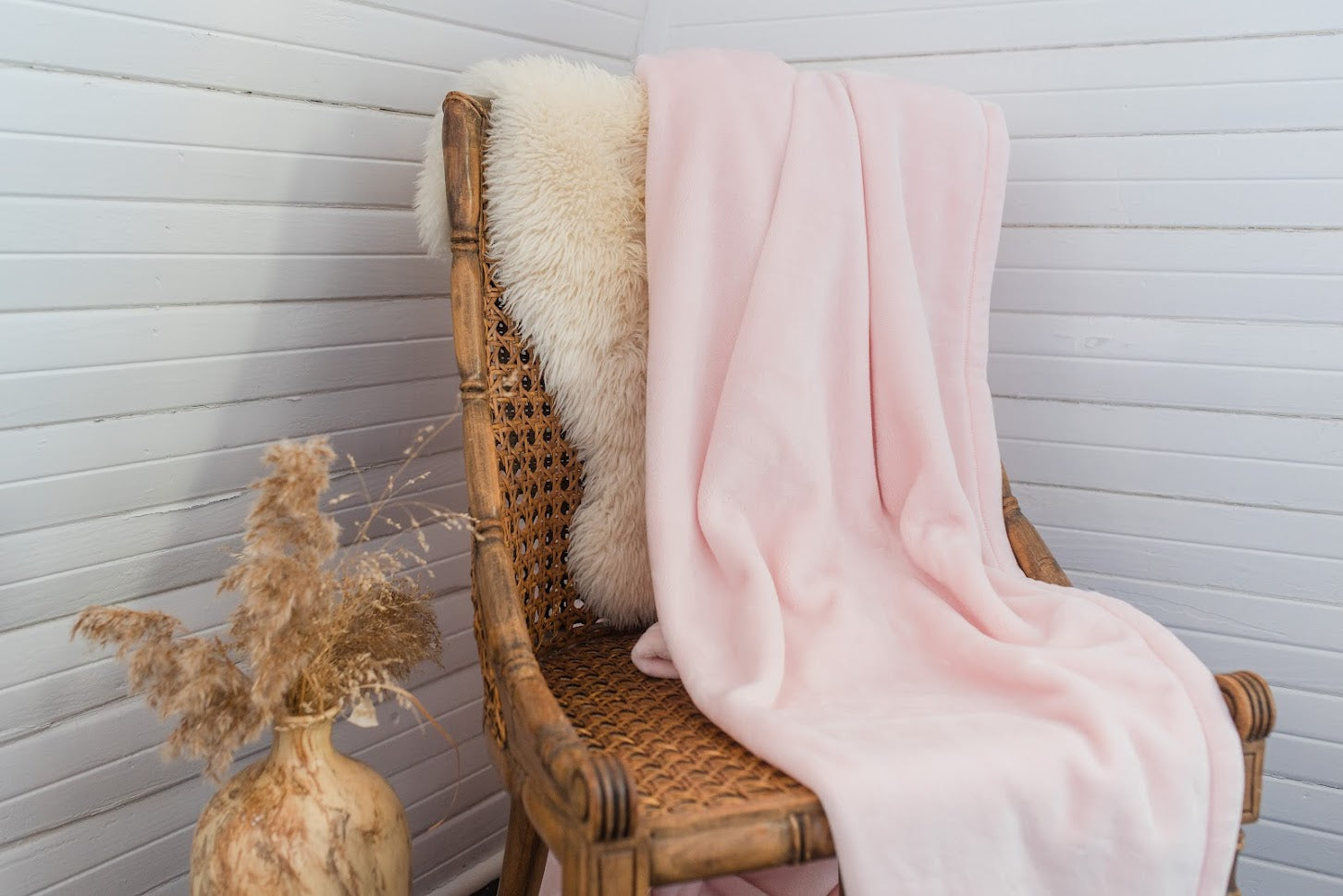
How to Make Soft Blankets: Why do we want to build a better blanket when there are millions of blankets for sale today? The truth is most blankets and bedding on the market are not made with high-quality fabrics. They’re quickly manufactured, using cheap textiles. After just a few washes, the blankets look old and dingy, and will start to shed or pill.
Here are the seven steps we take to create the softest blankets.
Step 1: How to pick the best fleece fabric
You can see and feel the difference between our fleece blankets and other fleece blankets. The difference starts with the fabric we choose. Most fleece blankets are made from 144-filament yarns. We use 288-filament yarns. These fine filament micro-fiber yarns are part of what give blankets their key qualities of soft, plush, and warm.
Then we increased the weight of the base fleece fabrics too, making them at 14 ounces per square meter or 400 grams per square meter. The extra weight gives the blanket a more weighted drape. If you hold the blanket up in the air and drop it, you’ll see how a blanket “drapes”. The drape of a nice blanket fabric is important in how the blanket will drape when folded over the edge of a bed or as a throw blanket, over a chair or sofa in the living room or den. The heavier blanket weight also allows for better surface coverage and helps make a more durable blanket that lasts. And the extra weight also helps make the blanket a warmer blanket.
Once we have the best quality of fabrics, we then proceed with the next step.
Step 2: How to make a blanket feel soft & cozy
To make a soft and cozy blanket, we wanted to take the extra steps to ensure that our blankets will not shed or pill and are durable enough to withstand multiple washes.
To do this, we first raise the pile of a blanket by repeatedly brushing the blankets with brushing bristles. This is what makes the blanket lustrous and soft.
Most fleece companies brush their fleece once or twice to make the fleece look nice or feel soft. But to ensure that a blanket feels soft and stays soft and to prevent fleece from shedding, a blanket must be brushed again and again. We brush our fleece 6 times on both sides of the blanket fabric because a blanket should look and feel soft and cozy on both sides of the blanket—not just the side you can see.
Most companies only brush their blankets once or twice, for that instant soft sheen. However, a blanket must be brushed multiple times on each side to guarantee lifelong softness, without any shedding or pilling. Our blankets are brushed six times so that you can enjoy the soft luster for years to come!
Step 3: How to Cut Fleece Blankets for Any Bed Size
Typically, a fleece blanket manufacturer could stack and cut two-dozen blankets at a time. Our fleece blankets are cut by hand on a custom-made cutting table, one blanket at a time.
Two cutters work at a table; they carefully inspect each piece of fabric for any possible defects. The blankets are cut with a sharp electric blade. All our blankets are cut with precision, to ensure that every blanket is consistent.
Our blankets are cut generously, typically just a little bigger than might be needed, but customers tend to appreciate a little extra blanket to drape the edges of their beds. A twin blanket is 60x90” or an extra-long twin blanket is 60x96”. Queen fleece blankets are 90x90”, King Sized fleece blankets are 108x90” and oversized King blankets are cut at 120x90”. (Note: Luster Loft line runs 2” shorter in length across all blanket sizes). For a complete list of sizes and prices for blankets, see: Fleece Blanket Sizes & Prices.
Step 4: How to Sew Fleece Blankets (The Secret Overlock Stitch)
The hem of a blanket will often tell you all about the quality. A sign of poor quality would be a wavy or uneven hem. Using low-quality fabric and the lack of detail will leave you dissatisfied with your blanket purchase.
We use two kinds of sewing machines when we make our fleece blankets. We use a single needle sewing machine to sew in the American Blanket Company care content and branded label. This is stitched 4” down on the left side of the long side of the blanket. The second sewing machine is a hemming or stitching machine; a 5-thread, three-needle top and bottom cover-stitch machine, and this is used to sew the blanket’s 1” hem. We’ve had our greatest hem success using this machine for creating a durable hem that lasts and stands the test of time.
Lots of fleece blankets use a satin binding to ensure overall product softness, even on the hem. Our blankets, however, are already unbelievably soft and very durable, so we prefer to use a self-fabric hem, made of the same material as the blankets themselves.
Where the two hems meet, we use something called an over lock stitch to help enforce the four corners (the areas of a blanket likely to break down over time) from fraying or unraveling. An over lock is a kind of sewing stitch that sews over the edge of two pieces of the fleece blanket. The over lock uses a looper, fed by multiple thread cones to create thread loops that pass from the needle to the edge of the blanket so that the edges of the fleece are contained within the seam.
Step 5: Vacuuming Fleece Blankets Removes Fibers and Reduces Shedding
Brushing, shearing, cutting, sewing and hemming fleece blankets creates lots of little loose blanket fibers around the shop. Our job—make sure none of them arrive on your new blanket! Gently vacuuming the finished blanket removes any loose fibers that have clung to the fabric in the process of making a fleece blanket. We run each blanket through the vacuum twice to ensure that both sides of the blanket are free from any loose fibers.
Vacuuming the blanket has an additional positive effect in that the air and suction in the vacuum machine fluffs the nap of the blanket up a bit, prior to folding and gift boxing. This helps the blanket stay fluffed, even when it’s compressed in its gift box.
Vacuuming a blanket removes over 90% of the loose fibers and helps ensure that the blanket won’t shed or pill. Still, we recommend that customers wash and dry their blankets once before first use to be sure that any loose fibers are cleared from the blanket.
Step 6: Inspecting Fleece Blankets for Quality and Perfection
Each blanket we make has two blanket inspectors who check the blanket for any potential quality issues. We inspect for blanket length and width measurements, loose threads, holes in the fabric, dirt or stains and poor stitching along the hems.
A large percentage of our blankets are embroidered or monogrammed blankets. This means we inspect the monogramming or embroidery to make sure the blanket says exactly what the customer ordered, in exactly the color thread the customer requested.
Step 7: Packaging and Shipping Fleece Blankets for Customers
The best step in making better blankets is shipping them to customers around the world! We carefully fold and package each blanket, and promptly ship them to our loyal customers. Purchasing one of our blankets as a gift? We will wrap the blanket in a beautiful white box, topped off with a silver ribbon and gift tag.
American Blanket Company’s mission is to provide our customers with the finest quality blankets. We take extra steps and precautions to make sure our blankets are the softest you’ve ever felt.




